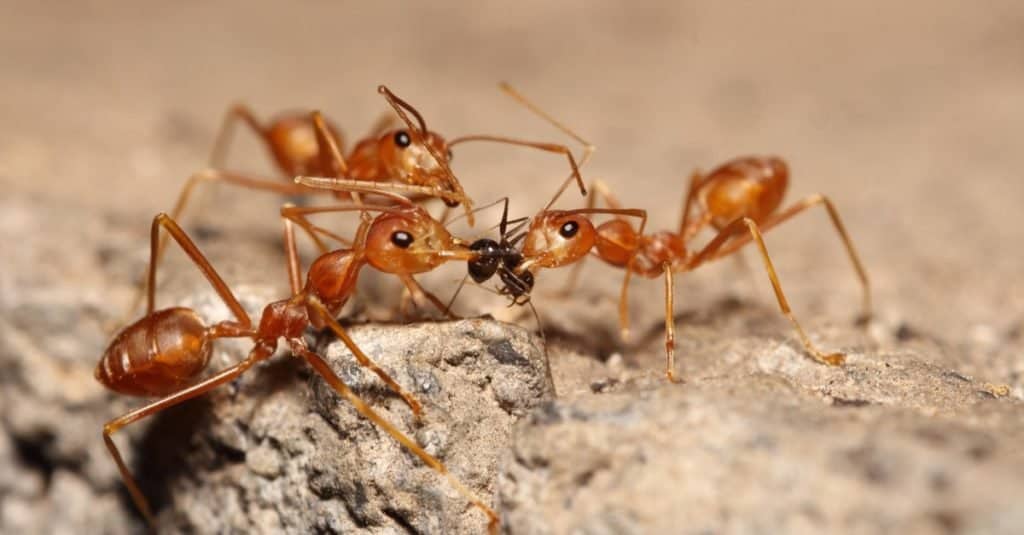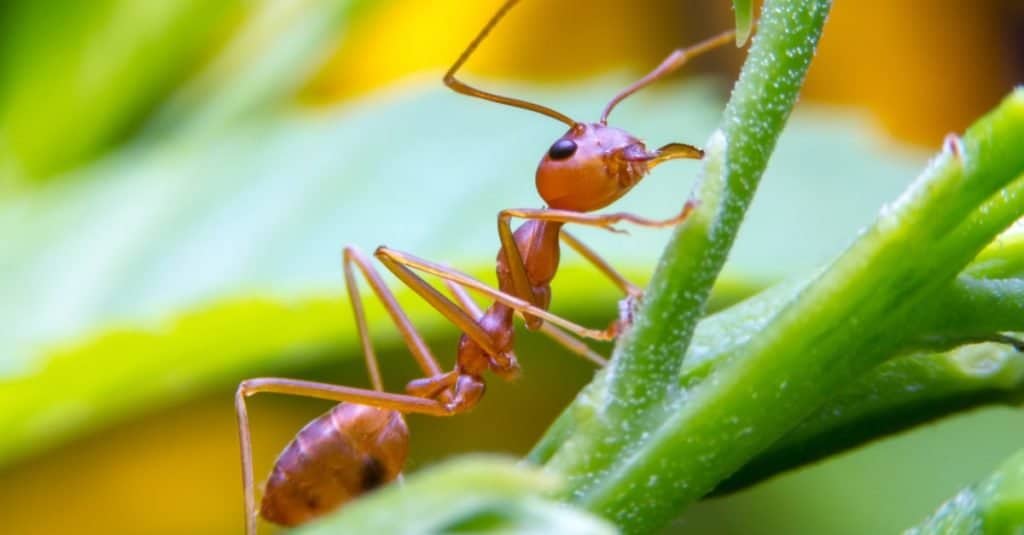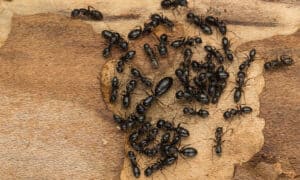The reddish-brown color of fire ants makes them instantly recognizable. However, many of us instantly associate them with their painful sting – which can cause quite a bit of pain! But do you know that they’re not even native to the U.S.? They were accidentally transported here on a cargo boat from South America. Over the years, they have spread throughout the entire country. This species of stinging ants is quite interesting to learn more about despite their pesky little bites. Have you ever wondered what these fascinating insects are all about?
Here, we’ll examine the fire ants’ interesting diet and what they eat before they’re fully grown.
What Do Fire Ants like to Eat?

Fire ants are classified as omnivores.
©NOTE OMG/Shutterstock.com
There is no such thing as a picky eater when it comes to fire ants. They are classified as omnivores, which means they consume a wide variety of food. This means they eat both plants and animals. There are many different kinds of plants that they like to eat, but they also enjoy eating microorganisms and microscopic organisms. You may not believe this, but they also like to eat invertebrates, like spiders, and vertebrates like lizards, birds, and different types of mammals. Ticks and boll weevils are also known to be preyed upon by fire ants.
Other types of food substances are also consumed by fire ants, such as sweet liquids produced by many types of plant glands called nectaries. They also feed on the honeydew produced by sucking insects like mites, flies, beetles, and mealybugs. There has been some evidence that fire ants damage agricultural crops, too, like corn and soybeans. Their diet consists of sprouting seeds, tunneling into the bases of young corn stalks and potato roots, and eating okra and fruit.
Let’s take a closer look at how fire ants hunt and forage for food now that we know what they like to eat.
How Do Fire Ants Hunt and Forage For Food?

It is possible for fire ants to kill small animals due to their aggressive behavior.
©sarawuth wannasathit/Shutterstock.com
As with many other species of ants, fire ants are known to forage for food in order to survive. As a result, the worker ants in the colony have to leave the nest and wander around in search of food in order to keep the colony alive. In the event that they discover a food source, they head straight back to their colony. They then use their stingers to mark the ground periodically and leave a trail of chemical pheromones along the way. A pheromone is a chemical that signals alarm, indicates trails to food, attracts workers to broods and the queen, and signals to males and females to reproduce.
Following the pheromone trail back to their colony, additional worker ants find the newly discovered food source. Those ants return to the colony with the food, as well as laying down a pheromone trail for the next group of ants. After a short time, many more ants follow the foraging trail, soon establishing a dominant position at the source to protect it.
In terms of predatory capacity, fire ant foragers are very effective. In order to bite and secure prey, these animals have powerful jaws that they use to bite. They can sting multiple times with their venomous stingers on the ends of their abdomens. In order to achieve this, fire ants use an enormous amount of force in order to paralyze and kill large animals. They carry their dead prey back to the colony after they paralyze it.
What Do Baby Fire Ants Eat?

An average fire ant queen ant lives for seven years and lays 1,600 eggs a day.
©wnarong/Shutterstock.com
Fire ants are classified as larvae when they are young. Every day, the queen of the fire ant colony lays around 1,000 eggs. Larvae hatch from the eggs and are fed by the workers. Protein serves as a basis for colony growth and expansion, fulfilling the colony’s basic needs. During the larval and queen stages, larvae and queens are fed protein.
In order to grow into adult ants, the larvae are fed chewed-up pieces by the workers. Solid food can not be digested by the workers themselves as they can only digest liquid food. In the same way that larvae require protein for their development, adult ants do not require protein in the same way. Meanwhile, the queen needs a constant supply of food in order to lay eggs and produce new ones.
What Do Fire Ants Eat In Captivity?
Ant colonies are popular pets among many people. For ants to survive, water and nutrition are essential. We mentioned earlier that fire ants are omnivores, which means they eat most things they can digest. So what is the fire ant diet like and what can fire ants eat when being kept as a pet?
Sources of Protein
Protein is essential to the survival of ants. An ant colony spends a lot of time gathering insects and other protein-rich items. Insects are the natural diet of all species of ants, so buy crickets, flies, earthworms, or other insects from a pet store. An adequate supply of protein is crucial to the health of the ants’ young. It is possible that they would die if they don’t get enough proteins.
Carbohydrates
It is no secret that ants love sugar. Some people have even reported seeing fire ants in their laundry rooms and homes because they are attracted to the sugars in the detergent. Since adult ants do not grow, they do not require protein like larvae and queens. In order to maintain their energy levels, workers need carbohydrates since they work day and night.
In a 2014 study done by Gavilanez-Slone, Jenny, and S. D. Porter., fire ant colonies were fed four artificial diets while the control group was fed crickets and sugar water. The colonies of fire ants that had been fed crickets and sugar water for 6 weeks had grown considerably and were healthy. Those colonies fed artificial diets, however, showed little or no growth, showing that these diets are unsuitable for raising healthy colonies of fire ants. Therefore, the fire ant has a high need for protein and sugar.
The photo featured at the top of this post is © wnarong/Shutterstock.com
Thank you for reading! Have some feedback for us? Contact the AZ Animals editorial team.







